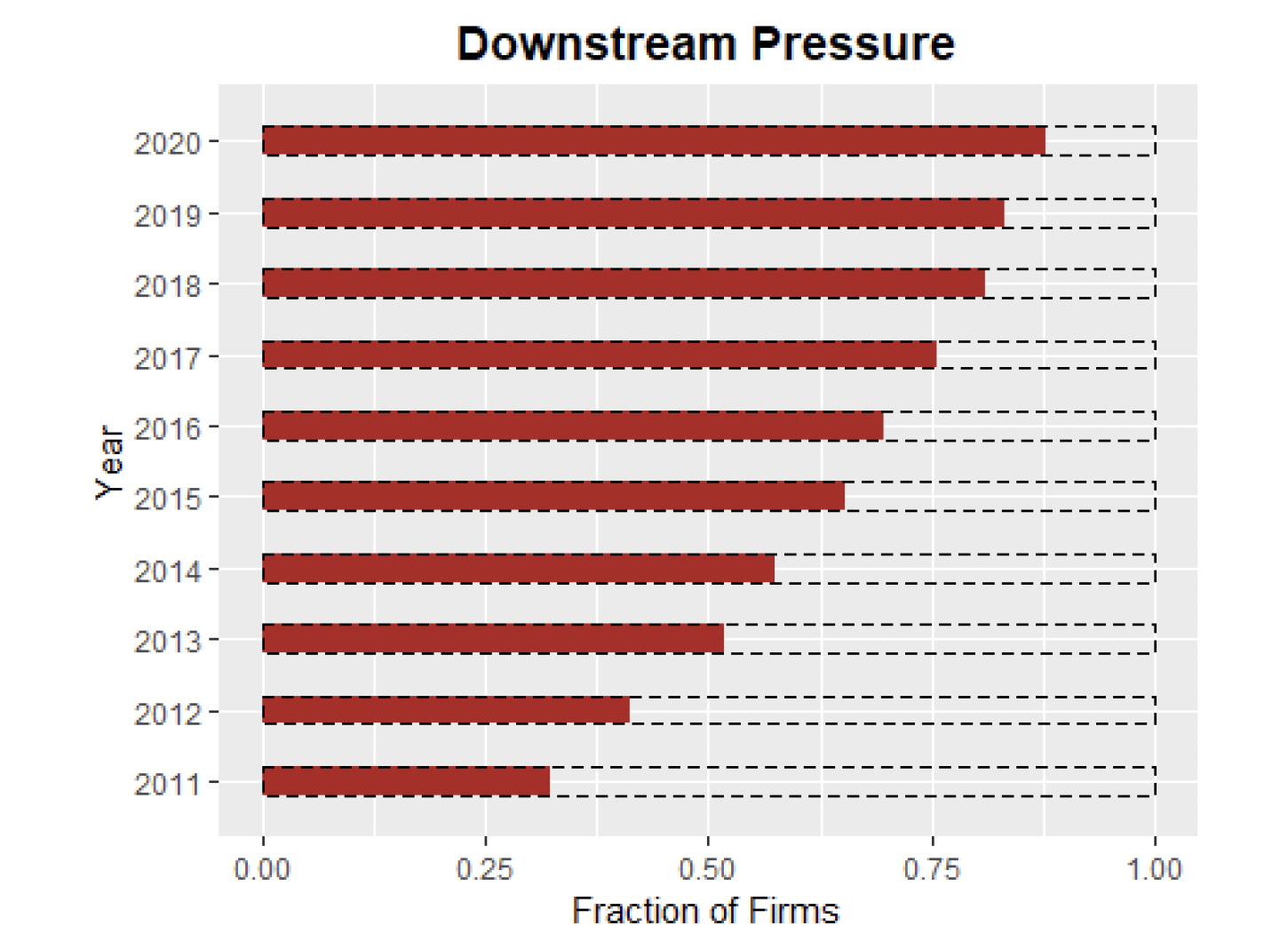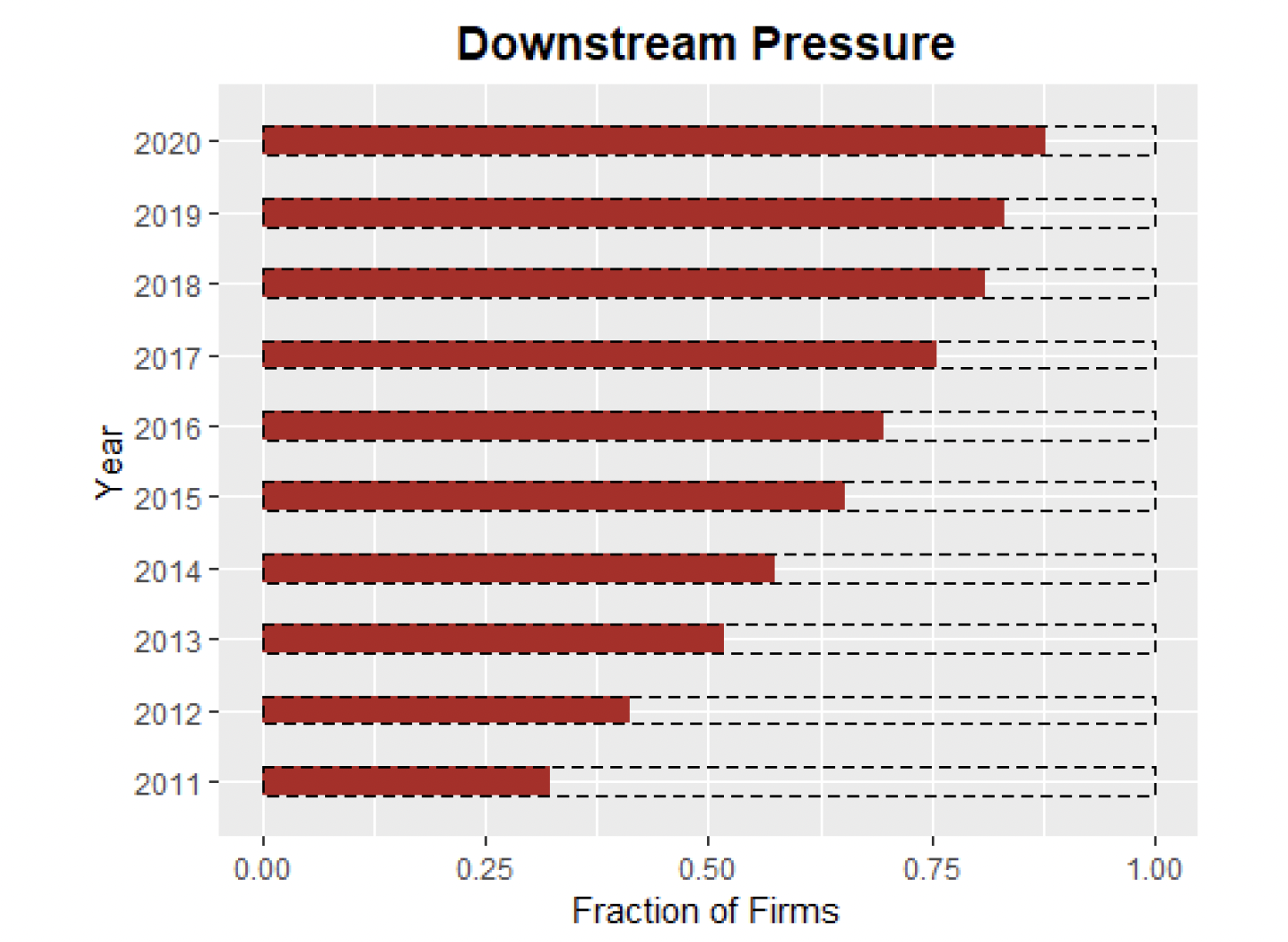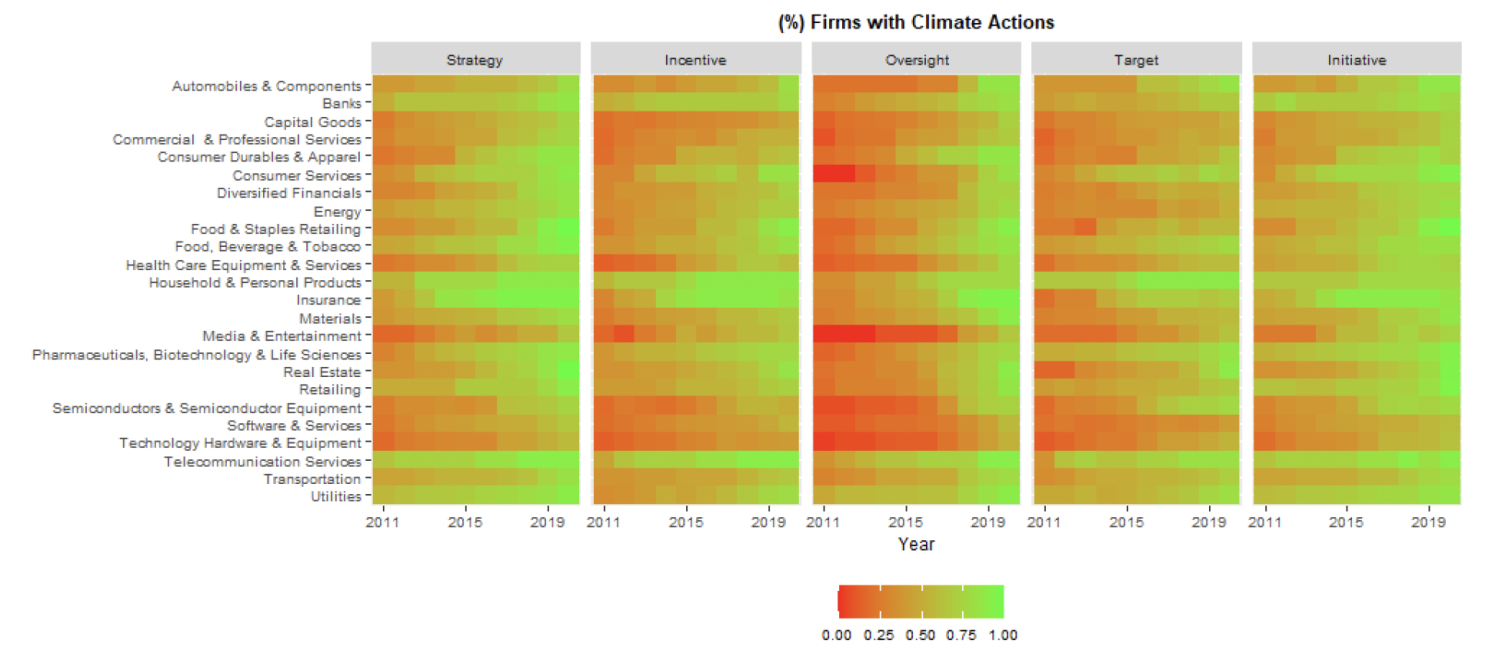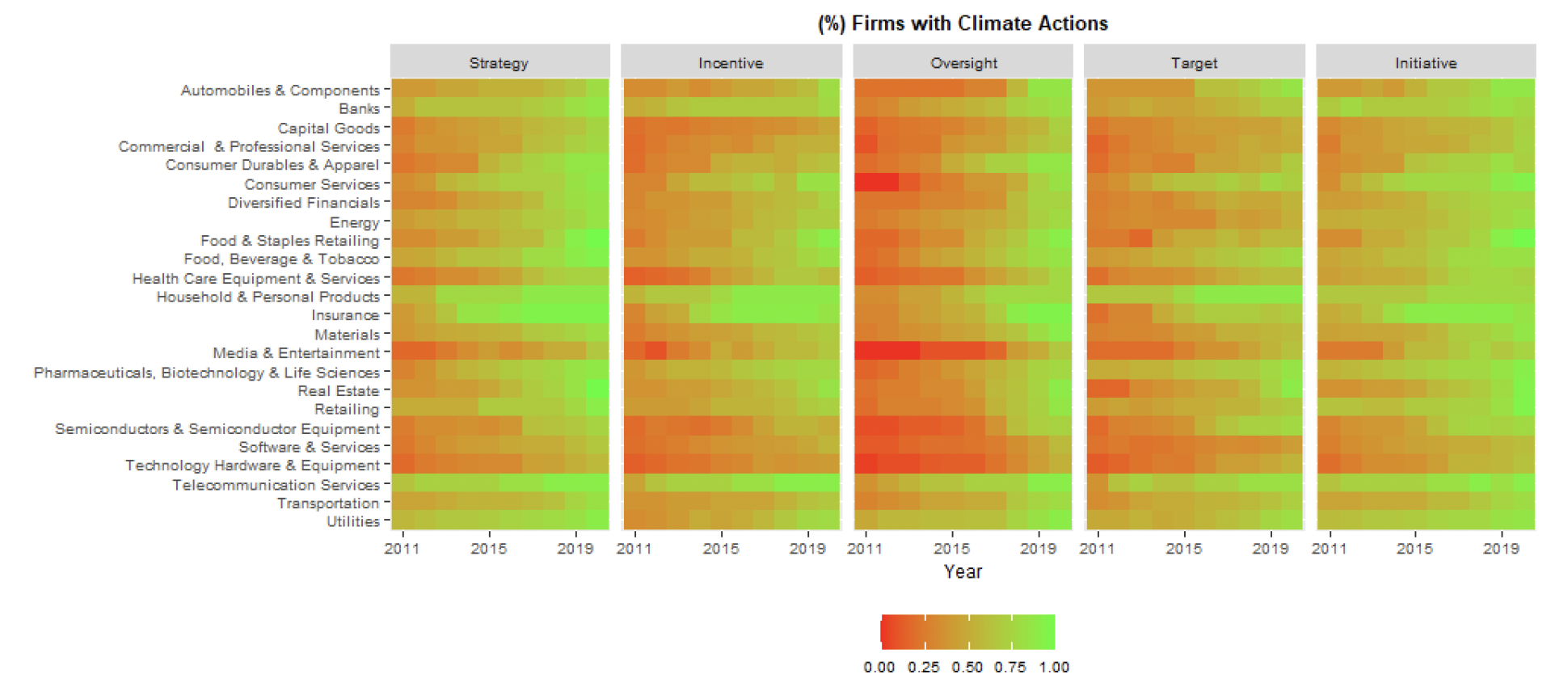Global supply chains are central to economic policy debates. This column examines recent attempts to regulate climate sustainability within supply chains. By analysing the corporate climate action and governance practices from a global sample of firms, the authors find increasing customer pressure on suppliers to decarbonise, but no evidence that emissions or energy inputs decrease when suppliers adopt climate policies in response to customer pressure. This policy-outcome gap illustrates the problem of greenwashing, which the authors suggest could be corrected by establishing better commercial terms in supply chain contracts.
Global supply chains (GSCs) have been central to economic policy debates since the COVID-19 pandemic. In the early stages of the pandemic, policymakers focused on the robustness and resilience of GSCs (Baldwin et al. 2023). In recent months, the discussion has expanded to include the climate sustainability of supply chains. In March 2024, the European Council approved the Corporate Sustainability Due Diligence Directive (CS3D), while the US Securities and Exchange Commission introduced the Climate Disclosure Rule. Both regulations propose, among other things, that firms report the climate impacts of their suppliers.
Climate resilience in GSCs is a salient issue because environmental protection and natural resource management problems occur across international borders, making them difficult for any single government to regulate. Recent research has shown that GSCs can act as vessels of cross-border policy diffusion (Adelino et al. 2023). The proponents of supply chain sustainability policies argue that European and US firms can spearhead the emission abatement initiatives of suppliers, thereby reducing climate risks for their investors and advancing the global decarbonisation agenda. The detractors of these regulations claim that such policies will burden firms with onerous compliance requirements and lead to superficial ‘greenwashing’ initiatives. It is a difficult debate to resolve because very little empirical evidence supports (or refutes) the assumption that GSCs can act as a conduit for emission reduction.
How should we think about sustainability in global supply chains?
Do suppliers take the lead from customer firms and adopt climate-responsible policies? In a recent paper (Homroy and Rauf 2024), we show that suppliers increasingly face customer pressure to decarbonise. Using detailed disclosure of corporate climate action and climate governance practices from a global sample of firms, we show that in 2011, only a quarter of suppliers faced emission-reduction pressure from customers; by 2020, that figure had increased to over 80% (Figure 1). Customer pressure to decarbonise varies by industry, but the time trend is persistent (Figure 2). In response to this mounting pressure, suppliers have begun to adopt emission-reduction targets, marking a significant shift in their climate-responsible policies. These adoptions are more likely when customer firms have bargaining power over suppliers. For example, suppliers of large firms are more likely to adopt emission-reduction targets than suppliers of smaller firms.
Figure 1 Customer pressure on supplier firms


Note: This figure plots the fraction of supplier firms which face downstream pressure from customer firms. Customer pressure is defined as having any customer which has set itself a GHG emission reduction target. We plot the fraction of supplier firms which faced customer pressure in a given year.
Figure 2 Industry variation in firms’ climate goals and incentives


Note: This figure plots the fraction of firms, across different industries, which respond affirmatively to the survey questions (questions C3.1, C1.3, C1.1, C4.1, C4.3, in that order). We heat code the the fraction of firms, in a given industry, which responded with a ‘Yes’ in a given year.
Is there evidence of greenwashing in GSCs?
However, the salient question is whether these adoptions lead suppliers to lower emissions and energy inputs. We find no evidence that emissions or energy inputs decrease when suppliers adopt climate policies in response to customer pressure. Since emissions and energy inputs are inherent to production technology, and substantial changes may not happen in the short run, it is not straightforward to draw a strong conclusion from these results alone. Hence, we question whether suppliers change their operating activities, which can lead to lower emissions in the long run. We find no evidence that suppliers’ adoption of emission reduction targets is associated with an increase in the leading indicators of abatement, such as capital expenditure and research and development expenses. We call this the ‘policy-outcome gap’, whereby climate policy adoption is transmitted through GSCs without a notable change in the climate outcomes of suppliers. A recent example highlights the challenges of translating green supply chain policies to measurable outcomes. In 2023, Tesco’s suppliers were found responsible for illegal deforestation in the Amazon, despite Tesco’s 2019 pledge to only source from deforestation-free suppliers.
Does this result suggest that supply chain sustainability is rife with greenwashing, as the detractors of the SEC’s proposal claim? Further analyses show a more nuanced picture. Suppliers with higher financial margins, a key factor in their ability to invest in green technology, increase their capital expenditure after they adopt emission-reduction targets following customer pressure, even though emissions do not fall in the short run. Similarly, suppliers geographically proximate to customer firms that facilitate better monitoring of their climate actions also increase investment in green technology.
Therefore, the policy-outcome gap decreases with better commercial terms and monitoring of suppliers’ climate actions. This is consistent with anecdotal evidence that Indian potato suppliers reduced water consumption and the use of harmful fertilisers when Pepsico offered guaranteed above-market prices to improve their sustainability practices (Cherel-Bonnemaison et al. 2020). A recent survey of automotive, electronics, and pharmaceutical industry sustainability practices confirms that many suppliers violate the required sustainability standards of these private regulations even when they comply on paper (Villena and Gioia 2020). Respondent suppliers of this survey highlight that slim profit margins and lack of oversight contributed to symbolic engagements.
A growing body of research shows that some firms respond to scrutiny by reconfiguring their supply chains away from ‘brown’ towards more climate-responsible ‘green’ suppliers (Pankratz and Schiller 2024, Bisetti et al. 2024). Since current supply chain linkages are economically efficient outcomes, replacing them en masse with more sustainable alternatives is costly in the short run (Ersahin et al. 2023). It will likely increase aggregate prices, reduce productivity, and lower competitiveness of the US and EU economies. Our results provide an alternative channel for climate-responsible supply chains. If customer firms can lead the adoption of climate-responsible policies to existing suppliers, then a ‘climate resilience-economic resilience’ trade-off can be less binding. We also provide insights into the economic origins of greenwashing concerns related to supply chains. These results inform ongoing policy discussions on sustainable supply chains.
Implications for future GSC sustainability policies
Regulators worldwide increasingly focus on corporate environmental due diligence to identify, prevent, and address environmental violations within their own and their direct suppliers’ operations. In response to these policies, customer firms often cascade these pressures upstream through bilateral private regulations of suppliers’ environmental standards and climate policies. Since writing explicit contracts on short-term environmental outcomes is difficult, it is common for customer firms to engage in ‘governance by exit’ (Kuruvilla 2021). This involves writing contract clauses that limit customers’ legal liabilities, allowing them to terminate contracts and indemnify suppliers in the event of an environmental scandal.
Such a ‘governance by exit’ strategy may insulate the customer firm from stakeholder pressure but does not progress the global climate agenda. An alternative approach is for customer firms to collect and monitor data on suppliers’ climate impact and support the transition to low-carbon production technology. However, this is a costly option for individual firms. Therefore, future generations of public policies on green supply chains need to encourage a shared responsibility approach to contracting. These regulations must incentivise firms to invest in monitoring and developing suppliers’ climate-resilient production capabilities. Incentives such as green subsidies and feed-in tariffs can trigger multiplier effects in the global decarbonisation drive.
Source : Voxeu



































































